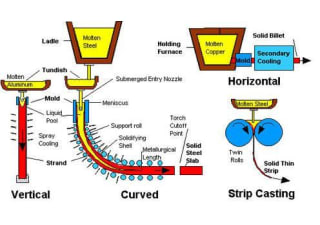
What is continuous casting, what is it for, what are the advantages?
What is continuous casting? The continuous casting process is a very effective method to manufacture semi-finished products such as bars, profiles, slabs, strips and tubes made from steel and non-ferrous metals such as copper, aluminum and their alloys. Nowadays, more than 90% of the liquid steel produced world-wide is processed by continuous casting, for example.
Even if there are different continuous casting techniques, there is no significant difference in casting steel, copper or aluminum. The essential differences are the casting temperatures, which range from approximately 700 °C in the case of aluminum to 1400 °C in the case of steel. The molten metal is continuously cast into a storage vessel called ladle and flows from there into a vertical or horizontal casting mold with open end. While flowing through the mold, which is cooled with water, the liquid mass takes the profile of the mold, starts to solidify at its surface and leaves the mold in a semi-solid strand. Simultaneously, new melt is constantly supplied to the mold at the same rate to keep up with the solidifying strand leaving the mold. The strand is further cooled by means of a water spraying system. Through the use of intensified cooling it is possible to increase the speed of crystallization and to generate in the strand a homogeneous, fine-grained structure, giving the semi-finished product good technological properties. The solidified strand is then straightened and cut to the desired length by shears or a cutting-torch.
The sections can be further worked upon in subsequent in-line rolling operations to obtain bars, rods, extrusion billets (blanks), slabs or other semi-finished products in various dimensions.
History of continuous casting
The first attempts to cast metals in a continuous process were made in the middle of the 19th century. In the year 1857, Sir Henry Bessemer (1813–1898) received a patent for casting metal between two contra-rotating rollers for manufacturing metal slabs. But that time this method remained without attention. Decisive progress was made from 1930 onwards with the Junghans-Rossi technique for continuous casting of light and heavy metals. Concerning steel, the continuous casting process was developed in 1950, before (and also after) that steel was poured into a stationary mold to form 'ingots'. The continuous casting of non-ferrous rod was created by the Properzi process, developed by Ilario Properzi (1897-1976), the founder of the Continuus-Properzi company.
The advantages of continuous casting
Continuous casting is the perfect method for manufacturing semi-finished products of long sizes and enables the production of large quantities within a short time. The microstructure of the products is even. Compared to casting in molds, continuous casting is more economical regarding the consumption of energy and reduces less scrap. Furthermore, the properties of the products can be easily modified by changing the casting parameters. As all operations can be automated and controlled, continuous casting offers numerous possibilities to adapt the production flexibly and rapidly to changing market requirements and to combine it with digitization (Industrie 4.0) technologies [1 and 2].
Literature
[1] Johann Penn, Paul Pennerstorfer, Andreas Jungbauer: New Generation of Continuous Casting Plants with Intelligent Manufacturing Strategy. in: BHM Berg- und Hüttenmännische Monatshefte, January 2018, Volume 163, Issue 1, pp 11–17.
[2] Andreas Flick, Christoph Stoiber: Trends in continuous casting of steel yesterday, today and tomorrow. in: Stahl und Eisen 131(11):S80-S91 (November 2011).
More information
http://ccc.illinois.edu/introduction/overview.html
http://thelibraryofmanufacturing.com/continuous_casting.html
http://www.kmmmetals.com/eng/kmm/nepartraukta_liesana2/
http://www.industrialmetalcastings.com/casting_continuous_casting.html
http://ccc.illinois.edu/PDF%20Files/Publications/04_McGraw_BGThomas_ConCast_revise3_21aug03_post.pdf
https://www.researchgate.net/topic/Continuous-Casting
https://www.chemie-schule.de/KnowHow/Datei:Stranggussprinzip.png
(in German)
The information has been compiled by Dipl.-Ing. Konrad Dengler, technical journalist and translator specialized in industrial topics.